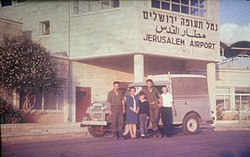Jerusalem International Airport: Difference between revisions
ref |
|||
| Line 37: | Line 37: | ||
==History== |
==History== |
||
[[File:EastJerusalemMap.svg|thumb|180px|Map of Jerusalem's 1967 municipal borders incorporating Atarot Airport in the north]] |
[[File:EastJerusalemMap.svg|thumb|180px|Map of Jerusalem's 1967 municipal borders incorporating Atarot Airport in the north]] |
||
Until 1930, the airfield in [[Kalandia]] was the only airport in the British Mandate for Palestine. It was used by the British military authorities and prominent guests bound for Jerusalem.<ref>''An Empire in the Holy Land: Historical Geography of the British Administration of Palestine, 1917-1929'' Gideon Biger, St. Martin's Press and Magnes Press, New York & Jerusalem, 1994, p. 152</ref>In 1931, the Mandatory government expropriated land from the Jewish village of [[Atarot]] to expand the airfield, in the process demolishing homes and uprooting fruit orchards.<ref name=orennordheim-kark>{{cite book| title=Jerusalem and Its Environs: Quarters, Neighborhoods, Villages, 1800-1948| author=Michael Oren-Nordheim, Ruth Kark| year=2001| publisher=Wayne State University Press| isbn=0814329098}}</ref> |
Until 1930, the airfield in [[Kalandia]] was the only airport in the British Mandate for Palestine. It was used by the British military authorities and prominent guests bound for Jerusalem.<ref>''An Empire in the Holy Land: Historical Geography of the British Administration of Palestine, 1917-1929'' Gideon Biger, St. Martin's Press and Magnes Press, New York & Jerusalem, 1994, p. 152</ref>In 1931, the Mandatory government expropriated land from the Jewish village of [[Atarot]] to expand the airfield, in the process demolishing homes and uprooting fruit orchards.<ref name=orennordheim-kark>{{cite book| title=Jerusalem and Its Environs: Quarters, Neighborhoods, Villages, 1800-1948| author=Michael Oren-Nordheim, Ruth Kark| year=2001| publisher=Wayne State University Press| isbn=0814329098}}</ref>In 1936, the airport was opened for regular flights.<ref>[http://www.jerusalemquarterly.org/ViewArticle.aspx?id=20 Atarot and the Fate of the Jerusalem Airport]</ref> The village of Atarot was captured and destroyed by the [[Jordan]]ian [[Arab Legion]] during the [[1948 Arab-Israeli War]]. |
||
The village was captured and destroyed by the [[Jordan]]ian [[Arab Legion]] during the [[1948 Arab-Israeli War]]. |
|||
From 1948 to the [[Six Day War]] in June 1967, the airport was under Jordanian control, after which it was incorporated into the Greater Jerusalem municipal area. |
From 1948 to the [[Six Day War]] in June 1967, the airport was under Jordanian control, after which it was incorporated into the Greater Jerusalem municipal area. |
||
Revision as of 05:50, 24 April 2012
Atarot Airport Jerusalem International Airport (CLOSED) שדה התעופה ירושלים | |||||||||||
|---|---|---|---|---|---|---|---|---|---|---|---|
 Entrance to Atarot Airport, 2010 | |||||||||||
| Summary | |||||||||||
| Airport type | Military/Public | ||||||||||
| Operator | Israel Defense Forces | ||||||||||
| Location | Jerusalem | ||||||||||
| Elevation AMSL | 2,485 ft / 757 m | ||||||||||
| Coordinates | 31°51′53″N 35°13′09″E / 31.86472°N 35.21917°E | ||||||||||
| Runways | |||||||||||
| |||||||||||

Atarot Airport (IATA: JRS, ICAO: LLJR, OJJR), (also Kalandia Airport and Jerusalem Airport) was a small airport located between Jerusalem and Ramallah. It was the first airport in the British Mandate for Palestine. It has been closed since the Second Intifada.[1]

History

Until 1930, the airfield in Kalandia was the only airport in the British Mandate for Palestine. It was used by the British military authorities and prominent guests bound for Jerusalem.[2]In 1931, the Mandatory government expropriated land from the Jewish village of Atarot to expand the airfield, in the process demolishing homes and uprooting fruit orchards.[3]In 1936, the airport was opened for regular flights.[4] The village of Atarot was captured and destroyed by the Jordanian Arab Legion during the 1948 Arab-Israeli War.
From 1948 to the Six Day War in June 1967, the airport was under Jordanian control, after which it was incorporated into the Greater Jerusalem municipal area.
In the 1970s and early 1980s, Israel invested considerable resources in upgrading the airport and creating the infrastructure for a full-fledged international airport but the international aviation authorities bowed to Arab political pressure and would not allow international flights to land there. Thus the airport was only used for domestic flights and charter flights.
During the Second Intifada in 2000, the airport became a target for stone-throwing and the runaways were littered by thousands of stones. In 2001, the airport was closed to civilian air traffic and handed over to the Israel Defense Forces. [5]
In maps presented by Israel at the Camp David talks in the summer of 2000, Atarot was included in the Israeli built-up area of Jerusalem.[6]This was rejected by the Palestinian delegation, which envisioned it as a national airport for the Palestinians. Yossi Beilin proposed that the airport be used jointly as part of an overall sharing of Jerusalem, citing the successful model of Geneva International Airport, which is used by both Switzerland and France. On 29 December 2009, the Palestinian Authority declared that the airport would be part of the future State of Palestine.[7]
ICAO codes
The airport is sometimes shown with two different ICAO codes. The LL designator is used by ICAO for airports in Israel and OJ is the code for Jordan.
See also
References
- ^ Larry Derfner (2001-01-23). "An Intifada Casualty Named Atarot". The Jewish Journal of Greater Los Angeles. Retrieved 2007-11-07 An Intifada Casualty Named Atarot.
{{cite news}}: Check date values in:|accessdate=(help) - ^ An Empire in the Holy Land: Historical Geography of the British Administration of Palestine, 1917-1929 Gideon Biger, St. Martin's Press and Magnes Press, New York & Jerusalem, 1994, p. 152
- ^ Michael Oren-Nordheim, Ruth Kark (2001). Jerusalem and Its Environs: Quarters, Neighborhoods, Villages, 1800-1948. Wayne State University Press. ISBN 0814329098.
- ^ Atarot and the Fate of the Jerusalem Airport
- ^ Atarot Airport handed over to the IDF
- ^ Atarot and the fate of the Jerusalem airport
- ^ PA cabinet discusses airport location
